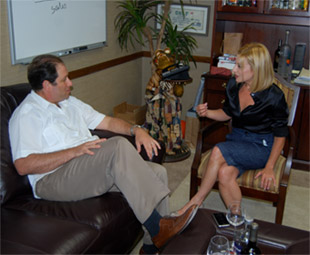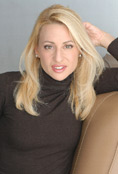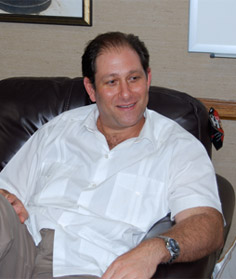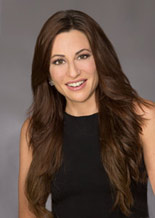Brett Graff’s Mixed Company
Crown Wine and Spirits CEO Bubba Kassal


This is the first in a series of interviews conducted by financial reporter Brett Graff, who under her trademark “The Home Economist” covers money, power and the economic forces affecting real people. A former U.S. government economist, her work has appeared in The Miami Herald, Maxim, Glamour, Good Housekeeping, Harper’s Bazaar, Ladies’ Home Journal, Redbook, Bankrate.com, TheNest.com, TheHomeEconomist.com and more. She’s been quoted by the Los Angeles Times, The New York Times, The Fiscal Policy Institute, Women’s Health, Yahoo! Finance, Cosmopolitan and Wikipedia and has made appearances on CNN, CNBC, PBS and Headline News.
Crown Wine & Sprits’ CEO Bubba Kassal has learned a lot since whipping up a batch of moonshine for his sixth grade science project. The 39-year old just returned from Harvard University, where he finished the first of a three-session program for business owners and operators. Now Kassal is applying his higher education to the three-generation, family-owned Crown retail chain, which is as much a part of the Southeastern Florida landscape as sea shells and palm trees. Growing to perhaps similar heights, the Crown retail business today earns $65 million in annual revenues and employs 250 people, and that’s without mentioning the corresponding real estate portfolio holding some prime tropical parcels.

We sat down for a drink after work with Kassal to get a taste of both his recipe for maintaining a successful empire, as well as the latest product lining his retail shelves – the Absolut Berri Acaí vodka. It’s a fruit infused-spirit that’s sweet enough to sip straight. But maintains a colorless pour suggesting it means serious business.
I suppose now is a great time to be in a recession-proof business….
Liquor sales aren’t recession proof, but they are resilient. People will still drink but their buying patterns will change. In fact, the number of bottles we sell will actually go up, but people buy less expensive brands. So instead of spending $30 you’ll spend $20 and instead of Absolut, you might buy Skyy and think, “It’s still premium.”
When it comes to your inventory, there was the Cosmopolitan craze, the Mojito rage – do you start the trends or ride the waves?
We ride the waves but we have to be smart enough to figure out what the trends are. We talk to our customers and know that when a wave happens it rolls over 30 locations. Right now, we know Beluga vodka is hot and the Skinny Girl margarita was an easy one to spot – when we see a show is taking off you can usually forecast that any drinks associated with the stars or the story will also be in high demand. When that happens, we work quickly to stock our shelves.
Tell us about the onset of Crown Liquors, and did you always know you’d go into your family’s business?
My grandparents started off in Manhattan making moonshine during prohibition. When they moved to Florida in 1955, the liquor business is what they knew, so they opened the first retail store here, on Sunrise Avenue.
I never for a second thought I’d wind up working with them, but I got a job in the business one summer and never left. First, I was a stock boy, then a salesman on the floor. Next I became in charge of ordering the beer and eventually, I expanded our cigar program throughout the company. Today we sell $1 million worth each year. There was no end.
And your family?
My dad is in the next office. He’s my mentor.
So what’s the best advice he ever gave you?
If you buy something for ten dollars and sell for $15, you can’t spend more than $5. That’s great advice: You can’t spend more than $5. I try to keep everything very simple.

What’s your biggest challenge?
I think the most terrifying realization is that you have an old company in a changing market and you have to figure out how to deal with what we call “legacy issues.” For example, in order for me to compete with today’s market, I would need to have computers in the stores and have a staff with a plan. That’s not exactly one of the strengths of an old company.
Is that why you went to Harvard?
I felt we were struggling to deal with current market conditions and legacy issues and I didn’t have the knowledge of how to deal with them. I was searching, unsure about what to do. I eventually realized that school was the best place in the world to figure it out.
And what’s it like to go back to school as a CEO?
I was there for 19 days — I will go back in February and the following February — along with 180 people from around the world. They split us up into sections of 8 and in 20 living groups, and they put us into an apartment situation. We all had private living accommodations in the back, but when you walk into the place, there was conference table in the front room. We’d meet at 7: 30 a.m. and begin the day with a discussion about a particular corporation. We took apart and analyzed every significant company doing business over the past 100 years.
And what did it do for your role at Crown?
It gave me the ability to look at my company the way I analyzed companies such as Dell, Amazon and Google. There’s a formula, and it starts by studying current conditions and asking some questions: What are your strengths and weaknesses? What does the current market look like? What does the competition look like? It doesn’t matter if you’re running a magazine or a mining company or a retail company. You have to differentiate yourself. You have to align yourself. You have to pull everyone together. Because you can have a strategy, but if you don’t have a way to accomplish it, everything falls apart.
What’s the first thing you did when you got back to your office?
It took me a month. Analyzing my company, examining the competition, talking to literally everyone and staying up until 3 a.m. most nights, but I put together a strategy. I call it “Our Road to Success.” Then I explained my vision, worked to get the buy-in, and now I’m executing it. That’s the role of a leader: to create a vision and a culture, tell people what their roles are going to be, and help them succeed.
That concludes the serious part of this interview. There are a few questions I can’t let pass. So here we go:
Who else was in your program at Harvard?
The most famous person there was Tyra Banks.
How did you get the name “Bubba?”
My real name is Paul. I have siblings 14 years older and after I was born, the doctor asked what they wanted to name me and “Bubba” was their answer. I’ve gone back to Paul once or twice but it didn’t stick. I’m Bubba.

Brett Graff is SocialMiami.com’s managing editor and has been a journalist covering money, people and power for over 20 years. Graff contributes to national media outlets including Reuters, Glamour, Harper’s Bazaar, Maxim, and the PBS show, Nightly Business Report. A former U.S. government economist, her nationally syndicated column The Home Economist is first published in The Miami Herald and then on the Tribune Content Agency, where it’s available to over 400 publications nationwide. She is broadcast weekly on two iHeartRadio news shows and is the author of “Not Buying It: Stop Overspending & Start Raising Happier, Healthier, More Successful Kids,” a parenting guide for people who might be tempted to buy their children the very obstacles they’re trying to avoid.


